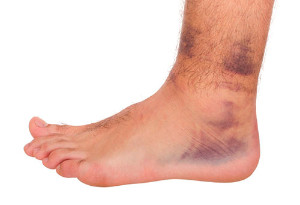 The medical condition that is referred to as osteoarthritis often causes pain and discomfort in the ankle. It can affect the joints in the ankles, and may happen as a result of injuries that involve the ligaments, or possibly from a dislocated ankle joint. Many patients incur ankle sprains or strains if they have fallen and injured the joints in the ankles. The symptoms between the two ailments are similar, and they include limited flexibility, pain and discomfort, and swelling. The difference lies in having muscle spasms that may accompany an ankle strain, and bruising is often seen on a sprained ankle. The chances may increase for having an ankle sprain or strain occur if the feet are not properly stretched. This may result in a lack of strength that is often needed to protect the body against falling. If you have any type of ankle pain, it is advised that you speak to a podiatrist who can offer you correct treatment options.
The medical condition that is referred to as osteoarthritis often causes pain and discomfort in the ankle. It can affect the joints in the ankles, and may happen as a result of injuries that involve the ligaments, or possibly from a dislocated ankle joint. Many patients incur ankle sprains or strains if they have fallen and injured the joints in the ankles. The symptoms between the two ailments are similar, and they include limited flexibility, pain and discomfort, and swelling. The difference lies in having muscle spasms that may accompany an ankle strain, and bruising is often seen on a sprained ankle. The chances may increase for having an ankle sprain or strain occur if the feet are not properly stretched. This may result in a lack of strength that is often needed to protect the body against falling. If you have any type of ankle pain, it is advised that you speak to a podiatrist who can offer you correct treatment options.
Ankle pain can be caused by a number of problems and may be potentially serious. If you have ankle pain, consult with Dr. Michael A. Wood from Foot Health Institute. Our doctor will assess your condition and provide you with quality foot and ankle treatment.
Ankle pain is any condition that causes pain in the ankle. Due to the fact that the ankle consists of tendons, muscles, bones, and ligaments, ankle pain can come from a number of different conditions.
Causes
The most common causes of ankle pain include:
- Types of arthritis (rheumatoid, osteoarthritis, and gout)
- Ankle sprains
- Broken ankles
- Achilles tendonitis
- Achilles tendon rupture
- Stress fractures
- Bursitis
- Tarsal tunnel syndrome
- Plantar fasciitis
Symptoms
Symptoms of ankle injury vary based upon the condition. Pain may include general pain and discomfort, swelling, aching, redness, bruising, burning or stabbing sensations, and/or loss of sensation.
Diagnosis
Due to the wide variety of potential causes of ankle pain, podiatrists will utilize a number of different methods to properly diagnose ankle pain. This can include asking for personal and family medical histories and of any recent injuries. Further diagnosis may include sensation tests, a physical examination, and potentially x-rays or other imaging tests.
Treatment
Just as the range of causes varies widely, so do treatments. Some more common treatments are rest, ice packs, keeping pressure off the foot, orthotics and braces, medication for inflammation and pain, and surgery.
If you have any questions, please feel free to contact one of our offices located in Lansing, and Chicago, IL . We offer the newest diagnostic and treatment technologies for all your foot care needs.
